What We Ate and Where
Honestly, we would have preferred to have trawled the streets as much as possible, this being the land of cheap and good street food. Unfortunately, things turned out otherwise. No, it was not because we were concerned about the cleanliness and levels of hygiene practised by the street hawkers. While the dubious conditions on Bangkok's streets may seem daunting for those who do not remember eating at rickety push-cart stalls next to rat-infested drains in Singapore or for those who do not care to remember those days, hygiene is not an issue for us. We have yet to experience any stomach-churning problems eating at similar stalls in Bangkok. Admittedly, we stick to some basic guidelines such as eating only food that has been freshly prepared (or at least recently re-heated), but surely these are commonsensical. Anyway, the standards of hygiene did not faze us this time round. The heat did. Unlike the cool dry weather of December, Bangkok in June is another story altogether. It was simply too uncomfortable to be eating spicy food out on the hot and humid streets, particularly in the day. Hence we had to contend ourselves with just two successful forays into street food territory.
Suan Lum Night Market
There are two areas within the grounds of this night market where Thai food can be found. The first is a giant food court, styled as a beer garden, where food is sold from concrete stalls (see below under "The Battle of the Food Courts"). The second is a row of stalls that appeared to have sprung up spontaneously along the edge of one of the carparks. This seemed like the genuine article so we checked it out.
Here's what we had:
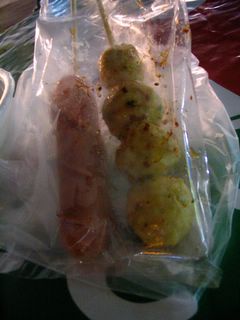
things onnastick - sausage and fish cake
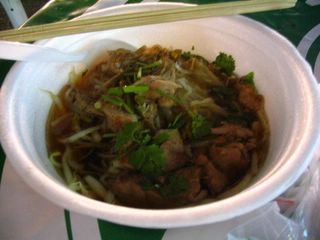
rice noodles (kuay tiaw) with duck
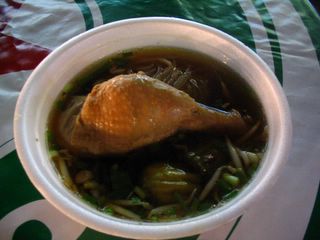
rice noodles with chicken and herbs
Of course the locals eat all these liberally dressed with various condiments including chilli sauce for the things onnastick, and ground paprika, sugar, chilli and lime for everything else. We were too chicken to do so - yeowwwch! - but even without the extras, it was food cheap and good. I liked the herbal taste of the rice noodles with chicken, while HM favoured the duck noodles.
The total cost of the meal? 95B (SGD $3.80) including 15B for a can of Diet Coke
Chatuchak Market
Within the grounds of sprawling Chatuchak market, we found this little gem of a stall which sold Isan* food.
*Northeastern part of Thailand

eating in Chatuchak
We had the following with sticky rice:
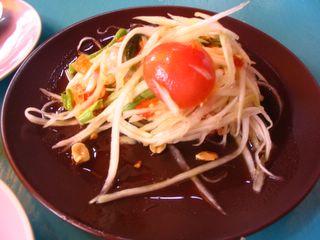
papaya salad with dried shrimp
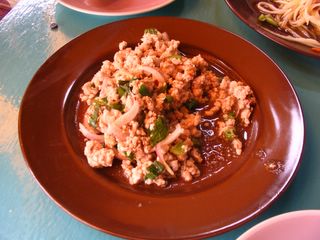
spicy minced pork
Surprisingly, the food was not too spicy, at least it was not overly spiked with chilli. Instead, it was refreshing to the palate and stimulating to the appetite, just the thing for a super hot day.
The bill came up to 110B (SGD $4.40) for the meal and two cans of Coke.
THE BATTLE OF THE FOODCOURTS
Suan Lum Night Market
If we had had a choice, we would probably not have chosen to eat here, this being the main reason:

Consider yourself forewarned - energetic young Thai artists will try to "spice" up your meal throughout the evening, with sentimental Thai ballads and cover versions of '80s American rock ("I Hate Myself For Loving You", anyone?). Moreover, the dining area, sheltered by a huge tent, was dimly lit, presumably for the purpose of the show. Put together, there was something rather depressing about the whole place.
The night we ate there, it was pouring, rendering the open air carpark stalls a non-event. On the plus side, there were more stalls here, although the range of offerings did not seem significantly wider, perhaps because a number of them seemed to serve the same thing - Thai style zhi cha.
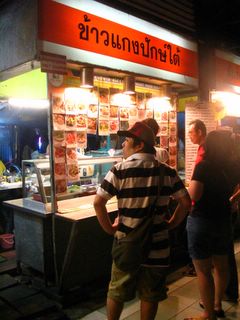
the stall we finally picked
and our menu for the night:

fried rice with shrimp paste

Thai "sukiyaki" made with pork
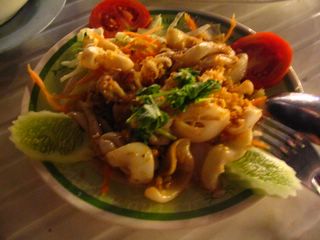
fried squid rings with garlic
As it turned out, the food was tasty, helped by the freshness of the ingredients and the light touch of the chef. The squid rings were tender and light, not soggy and oily. The fried rice was fragrant and delicious, lovingly garnished with Chinese sausage, taugeh (bean sprouts), freshly cut lime and chilli. The discovery for us though was what the menu (and the ladyboy who took our order) called Thai sukiyaki. It was essentially glass noodles, slices of pork, cabbage and other vegetables, cooked in a thick broth made from pork stock, and given a touch of heat with the addition of chilli flakes. It was comfort food with a twist (the chilli lah!)
The cost of this repast came up to 160B (SGD $6.40).
The Foodloft, at Central Chitlom
And now, for something completely different... Central Department Store's flagship store at Chitlom houses a sleek and stylishly designed food court. The concept should be familiar to Singaporeans - each customer is issued with a card that he uses to record his purchases at various food stalls, and he pays as he leaves the food court. Think Marche's.
Judging from the size of the crowd having lunch there on that Sunday afternoon we chose to check it out, the Foodloft is highly popular with both locals and foreigners. At the rate that people were walking past with pizza, that seemed to the big hit. In addition to Italian food, there was a range of international cuisine, including food from Malaysia and Singapore.
We opted for:
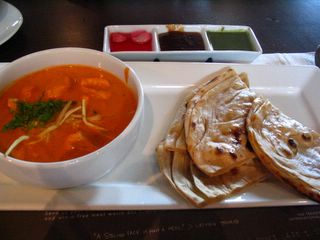
butter chicken and prata
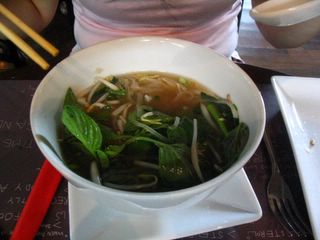
Vietnamese pho
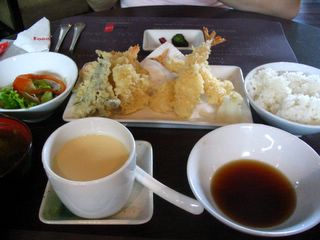
tempura set
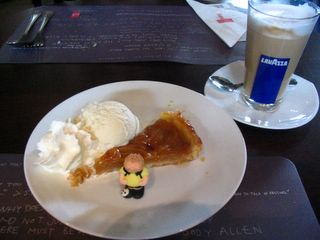
apple tart with ice cream, and latte
In general, the food was competently prepared and well-presented. The butter chicken and paratha stood out. The paratha was truly light and fluffy. HM who is usually not a fan of butter chicken really liked this version. The other highlight was the apple tart - to die for! Unfortunately, it came in a teeny slice, so people who live for desserts should really order their own portion and not share with friends. For value for money, the tempura set was unbeatable. Again, ingredients were fresh and the tempura batter was oh so light, and to top it all, it only cost 250B or SGD $10.
The meal in summary:
Vietnamese pho – 80B
Butter chicken – 160B
Paratha – 60B
Masala tea – 50B
Tempura set (assorted tempura, chawan mushi, miso soup, rice, salad, pickles) – 250B
Apple tart with ice-cream – 109B
Total: 807B (SGD $32.28) including 5% service charge - not cheap cheap but worth it.
Fifth Avenue, at Mahboonkrong Shopping Centre
From all the advertising being done inside MBK itself, it seemed like Fifth Avenue, on the fifth floor, had just been opened. Our guess was MBK was trying to cash in on the popularity of new-style food courts like the Foodloft. Hence, the place was again stylishly done up, black and white and glass everywhere. However, there was nary a customer in sight when we first arrived. That should have tipped us off, but we put it down as it being a new eatery, and perhaps one too posh for the down-to-earth MBK crowd. After all, there was a well-patronised and much cheaper food court on the floor above.
Anyway, we needed a respite from the madness that is MBK, and so we wandered into Fifth Avenue and ordered the following from the stall selling Thai favourites:
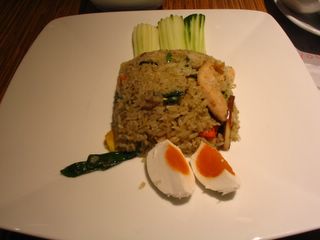
green curry fried rice, with salted egg

fish maw soup with rice noodles
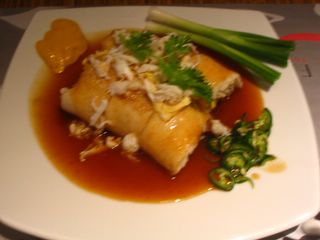
fresh spring rolls
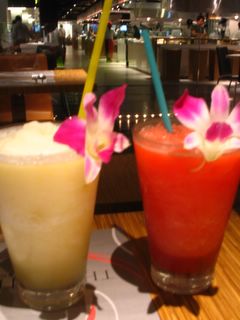
pineapple slushie and watermelon slushie
The food looked better than it tasted. It was hard to pinpoint what exactly was wrong with it, except that it left us with a vague dissatisfied feeling. The fish maw soup was a gooky mess, the kind of starchy soup served in bad Chinese cuisine. The fresh spring rolls came covered in yet another starchy sauce. The green curry fried rice was the best of the lot, but even then, it was no better than what Thai Express in Singapore would serve. Could it be that the food was over-processed, so much so that the freshness of the ingredients no longer came through? Or that it had been pre-prepared and merely heated up? All in all, it was a mediocre eating experience, albeit in a posh setting.
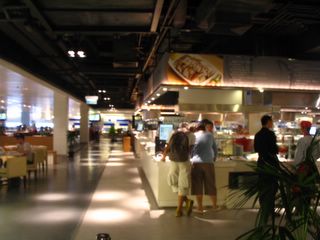
Trying hard
The total cost of the meal: 420 B (SGD $16.80), cheaper than our meal at the Foodloft but for less food and certainly to less satisfying effect.
RESTAURANTS
Ban Chiang
Going to Ban Chiang meant venturing a little out of our usual territory of the Siam Square-Sukhumvit districts. We found it within walking distance of the Surasak BTS station, amidst towering office skyscrapers, a quaint old house, lovingly restored and conserved.
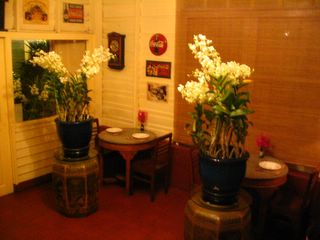
pretty, ain't it?

the main dining area

where we sat
Oddly enough, the music of choice was chill-out lounge. Clearly, the target clientele was farang (Thai for "foreigner"), and more likely than not, the owner a farang as well. No matter, as long as the food was good...
Ban Chiang serves Thai and Isan food. The night we were there, we were not feeling too adventurous and ended up ordering the usual favourites:
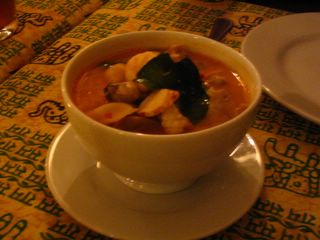
seafood tom yam
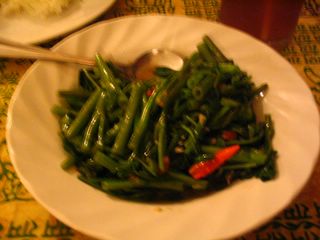
stir-fried morning glory

minced pork omelette

fried garoupa with garlic and pepper

iced lemongrass drink
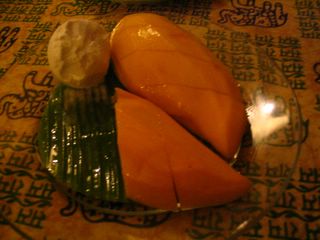
mango with coconut ice cream (or was it coconut ice cream with mango?)
While the ambience and setting were clearly the highlight of the dining experience, the food was not to be sniffed at. Overall, the standard of cooking was good, and then there were the little surprises like oysters in the tom yam. We also liked the iced lemongrass drink, infused as it was with honey and lemongrass. For 873B (SGD $34.90), including 5% service charge, for the whole meal, it certainly represented good value for money.
AOI, AT SIAM PARAGON
We read somewhere that Japanese food in Bangkok is better than that of Singapore's. For one thing, it is more authentic apparently, not that we would know how to distinguish "real" Japanese food from "fake" Japanese food. Still, we were game to try a Japanese restaurant if time permitted. Ensconced within the luxurious confines of Siam Paragon one day, and loath to go forth into the blistering heat, we opted for one of several Japanese restaurants within the complex. Fuji which is reputedly the most popular was indeed quite full, so we picked the next busiest, and Aoi was it.
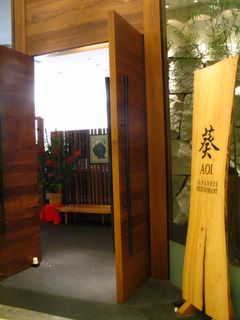
The place was well laid out, in a contemporary Japanese style, with each area beautifully decorated. The aethestically pleasing design certainly created a rather pleasant environment for a peaceful lunch, just the thing to calm and soothe nerves frazzled by endless shopping (oh, the travails of tai-tais...)
As for the food, we ordered two bentos, which included chawan mushi, rice, miso soup and dessert:
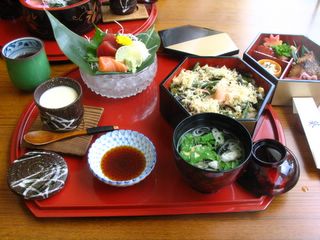
wild vegetables set
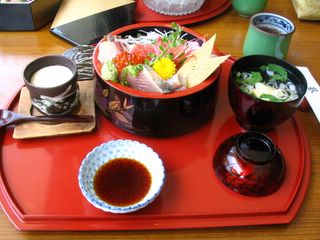
chiraishi set
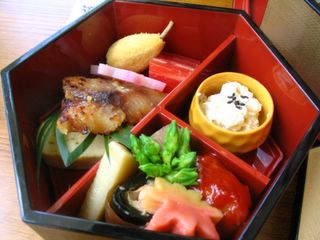
a closer look at some of the side-dishes

and the bonito-covered wild vegetables on rice
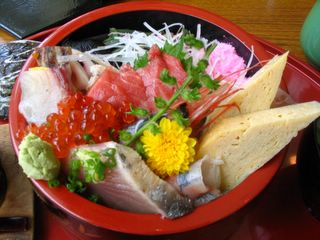
an eyeful of luscious seafood
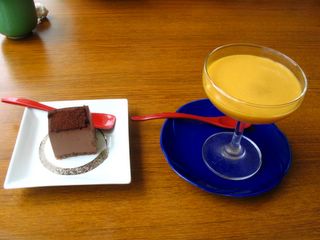
dessert - chocolate mousse and mango pudding
Great care had been taken to achieve a presentation worthy of the freshness of the sashimi. Overall, both the quality and quantity of food were hard to beat for the cost of the meal, a mere 1589B (SGD $63.56). If this was representative of the average Japanese restaurant in Bangkok, then it may well be true that Singapore's pale in comparison.
LEMONGRASS
Lemongrass was one of the restaurants on our list of to-dos. Conveniently located just next to Emporium at Sukhumvit Soi 24, it was easy to get to; just get off at Phrom Pong station, walk through Emporium and out the side entrance, and there it is.
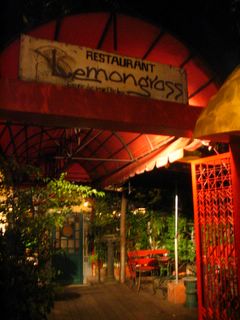
funny how every restaurant named Lemongrass uses the same font, even though they're not related
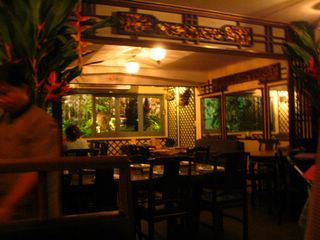
inside the restaurant
Like Ban Chiang, Lemongrass is housed in a carefully conserved old house, but the food is quite different. While Ban Chiang's menu and presentation can be described as rustic and traditional, Lemongrass' is modern and updated, what one web-based reviewer termed as nouvelle Thai cuisine.
popiah, modern thai style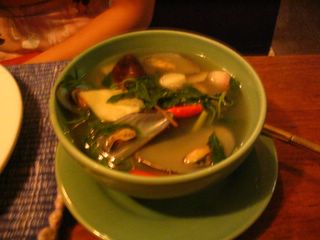
steamed mussel soup
roast duck salad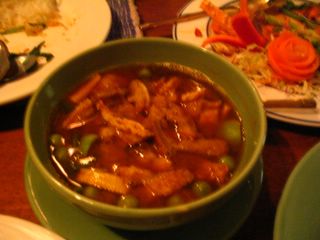
pork curry, with nightshade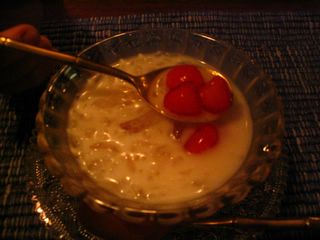
water chestnut with coconut milk
The steamed mussel soup was loaded with basil, lemongrass and pineapple, a good appetite-inducing starter. The popia was not what we expected. The menu description read "popia with minced pork and salted egg". Given the name, we had thought it would be the usual fresh spring rolls, albeit with a twist in the ingredients. This turned out to be like deepfried pancake, the crust probably made with popiah skin, stuffed with presumably a minced pork and salted egg paste. The texture reminded us of the stuffed yu tiao we get at home, crispy on the outside and soft on the inside, and it was served with a similar sweet and sour sauce. It was pleasant enough, but not outstanding, particularly since there was no hint of the salted eggs.
The piece de resistance for us was the roast duck salad, the epitome of everything good about the Thai salad genre, a tongue-tingling lip-smacking blend topped off with delicious shreds of roast duck. The meal was worth it for the salad alone, but the pork curry was also a discovery for us. It was more like a stew than a curry (I gather that the tendency is to name everything with a gravy a curry in English, although in Thai, a "gang" is not necessarily a curry per se.) It was indeed piquant, as described in the menu, and tasty.
The meal ended with water chestnuts with coconut milk, what restaurants and dessert stalls in Singapore normally call "red rubies". That it was not a more exotic dessert was my bad, my fault - I have an inordinate liking for this - but, as it turned out, HM who usually does not like this particular dessert really enjoyed it. If nothing else, it was the real thing, made with real coconut milk and not the canned variety.
Together with 3 iced lemongrass drinks, the bill came up to 965B (SGD $38.60). Unlike the other restaurants, there was no service charge.
CAWFEEE....
latte Thai style
A Singaporean friend living and working in Bangkok warned us about the incredible sweetness of Thai style coffee. We did not understand. After all, how sweet can a latte - expresso and steamed milk - get, right? Wrong. As understood by the many stalls selling Thai style coffee, a latte is made of milk AND creamer AND condensed milk AND sugar, oh, and yah, a small dose of coffee (albeit a decently strong blend). It was so sweet it put our teeth on edge.
Fortunately the same friend brought us to Doi Tung, at Suan Lom Night Bazaar.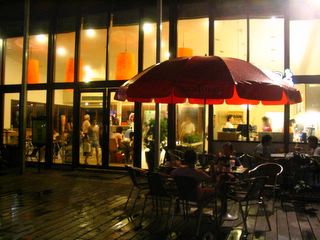
styled like Starbuck's and other trendy coffee chains
I hesitate to call Doi Tung a Thai Starbucks, because that would be an unfair comparison - Doi Tung's house blend, as used in their lattes, is so much better than Starbuck's, and at no more than 95B (SGD $3.80) a pop too. So, in our opinion, the reputation of Thai coffee was saved by Doi Tung.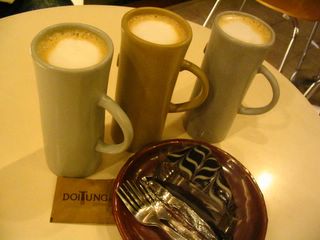
latte and cake at Doi Tung
AIRLINE FOOD, COURTESY OF SIA
(if you must know...)
SIN-BKK: pad thai from Changi, or so it seemed...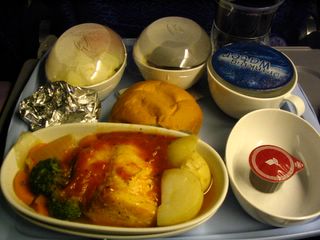
SIN-BKK: chicken or fish, you guess?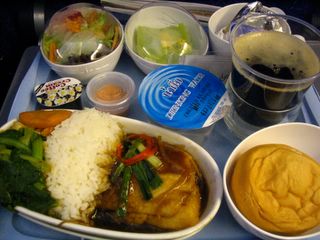
BKK-SIN: fish and rice, Chinese-style
BKK-SIN: chicken and potatoes


0 Comments:
Post a Comment
<< Home